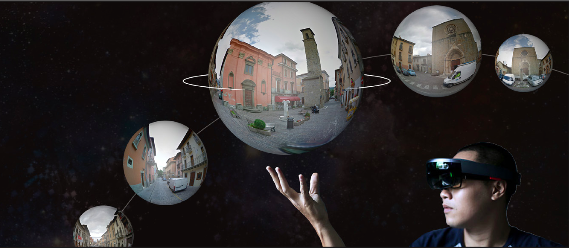
Janus: a view of the past through the eyes of the future
Like Janus, a Roman and Italic god, who simultaneously looks to the past and the future, Janus, the new startup of Sapienza University of Rome, aims to have "a view of the past, through the eyes of the future".
Janus, the first startup of the Faculty of Architecture of Sapienza University, combines academic skills with Information and Communication Technologies (ICT) - such as virtual reality, augmented reality, three-dimensional reconstructions, virtual/interactive panoramas and virtual museums - to produce high-quality content to be offered to a specialist market, both public and private, such as museums, culture ministries, municipalities and foundations.
Painting, sculpture and architecture have always had a pedagogical role based on the conscious use of visual language to convey specific messages in an evocative and immediate way," says scientific coordinator Graziano Mario Valenti of the Department of History, Representation and Restoration of Architecture at Sapienza University. "The cultural operation we intend to pursue is to share knowledge, without the user's background being a discriminating factor, and to stimulate a sense of participation and emotional involvement in the cultural heritage".
This concept translates into a virtual museum not simply as a "container" of art, but as a place, a tool for interaction and dynamism̀ in which the visitor is freed from the limits of gravity and impenetrability of bodies. It is then possible to imagine that, for instance, two-dimensional canvases can become three-dimensional rooms in which the observer enters the scene, merges with the space of the work of art, accessing a different and privileged point of view. The aim is to propose an experience that does not replace, but complements and supplements the real experience.
The virtual construction/reconstruction process will essentially take place in three phases: in-depth knowledge of the object of study, the production of the contents by analysing the data acquired for the construction of the virtual models, and the object's communication with innovative solutions. In all these phases, from design to commercial realisation, the diverse and interdisciplinary skills of the working group members made up of lecturers, doctoral students and young graduates of the Department of History, Representation and Restoration of Architecture will be fundamental.
Janus presents itself as a "digital craftsmanship" company where innovation is developed by balancing creativity and skills," continues Simone Lucchetti, architect, under-30 doctoral student at Sapienza University and president of the startup. "Janus is innovative because it aims to give a new meaning and value to virtual reconstructions using technology as a means of conveying content."
Besides, Janus guarantees a high degree of customisation for the products and services provided, which can also be integrated, to meet the client's needs and fit the criteria of the end user's analysis.
To be understood, cultural heritage communication must use immediate communication tools that involve the user at an emotional level, without diminishing or trivialising the contents. Therefore, the Janus project was born to improve the traditional model of communication by creating products that, helped by technological means, tell stories and offer experiences, bring closer and make the cultural heritage and the values it expresses a part of an increasingly large and heterogeneous community of users.
In addition to Graziano Mario Valenti and Simone Lucchetti, the entrepreneurial team comprises the lecturers Fabrizio De Cesaris, Tommaso Empler, Elena Ippoliti and PhD students and postgraduates Roberto Barni, Daniele Bigi, Adriana Caldarone, Giulia Catalani, Marika Griffo and Antonio Mirandola, all belonging to the Department of History, Representation and Restoration of Architecture. A total of eleven people are involved in all phases, from design to production and marketing of innovative products that provide new value and new meaning to virtual reconstructions of cultural heritage.
Further Information
Graziano Mario Valenti
Department of History, Representation and Restoration of Architecture
grazianomario.valenti@uniroma1.it



